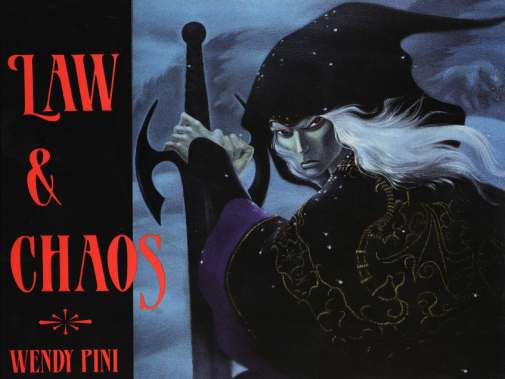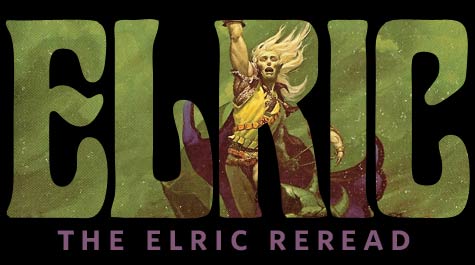When I was thirteen, I stumbled across a book that would change my life in a Nag Champa-scented New Age bookstore in Austin. The book was called Law and Chaos, and I was drawn to it by the cover illustration: a hauntingly fey, ghost-pale figure in a hooded black cloak, holding a massive broadsword that had a hilt like a pair of bat wings. I had no idea what it was, but I knew I wanted it, and somehow I conned my father (who has always been patient with my various fixations and enthusiasms) into buying it for me.
 It turned out to be Wendy Pini’s chronicle of her college attempt to create an animated film based on Michael Moorcock’s Stormbringer—a gorgeously illustrated volume and a fascinatingly candid memoir of how sometimes the creative process doesn’t quite turn out the way you planned. After I’d read her book cover to cover a few dozen times, I acquired the seven silver-covered Ace paperbacks that, at the time, made up the Elric saga—one at a time, with the careful management of my allowance money and several trips to the local Waldenbooks in the mall.
It turned out to be Wendy Pini’s chronicle of her college attempt to create an animated film based on Michael Moorcock’s Stormbringer—a gorgeously illustrated volume and a fascinatingly candid memoir of how sometimes the creative process doesn’t quite turn out the way you planned. After I’d read her book cover to cover a few dozen times, I acquired the seven silver-covered Ace paperbacks that, at the time, made up the Elric saga—one at a time, with the careful management of my allowance money and several trips to the local Waldenbooks in the mall.
If you’ve ever read Neil Gaiman’s “One Life, Furnished in Early Moorcock,” you may have a sense of what kind of effect those books had on me. Exact circumstances of gender and schooling aside, the boy in that story might as well be my doppelgänger. I became obsessed with Elric, with his doomed destiny, his dark moods. At one point it was so intense that I actually turned in what amounted to a piece of Elric fan fiction for an English class assignment in creative writing. That it got me an A+ says something about me, my teacher’s patience, and the school I was attending, but to this day I’m still not sure exactly what.
Michael Moorcock sometimes seems to me like the genre fiction equivalent of one of those bands that gets referenced by all your favorite musicians (like Cabaret Voltaire or Captain Beefheart), but which hardly anyone you personally know seems to listen to. In addition to Neil Gaiman’s tribute in the form of a short story, Moorcock’s characters have cameos in Alan Moore’s League of Extraordinary Gentlemen, and Moore supplies the gorgeous, inventive meditation “The Return of the Thin White Duke” in the Del Rey Stealer of Souls and Gollancz Elric of Melniboné and Other Stories collections. Dave Sim spoofed Elric with the Foghorn Leghorn sound-alike Elrod of Melvinbone in Cerebus. But even in my nerdy circles of friends, it seems like only a scant handful have ever read the originals.
Fortunately Tor.com has granted me a platform where I can get all my proselytizing on Moorcock done in one convenient place. Over the next few months, I’ll be doing a reread of the Elric saga from start to finish, discussing each book in turn and hopefully doing justice to why I think these books are classics. And if that goes well, there may be yet more Moorcock in the future.
The chronology of how to present this reread required some contemplation, not least because the most recently available editions in the US, published by Del Rey, present the stories in publication order rather than according to Elric’s personal chronology. There’s a lot to be said for that approach, given Moorcock’s evolution as a writer and the ever-expanding mythos of his Multiverse and how it informs Elric’s stories in the books written later—but the upshot is that the first Del Rey volume, Stealer of Souls, includes what is effectively the grand finale of the epic, Stormbringer, and everything after is interpolated adventures that take place around that and the first published Elric story, “The Dreaming City.”
Meanwhile, Gollancz in the UK is engaged in an epic re-issue of definitive editions of over 30 print volumes of Moorcock’s oeuvre, edited by Moorcock’s longtime bibliographer John Davey, and they’ve chosen to present the Elric volumes in chronological order (save for the Moonbeam Roads trilogy of The Dreamthief’s Daughter, The Skrayling Tree, and The White Wolf’s Son, which were published first because they’d never been in print in the UK before; they’re appearing under the revised titles Daughter of Dreams, Destiny’s Brother, and Son of the Wolf).
So what’s a determined re-reader to do? Well, since Gollancz notes that it’s the author’s preferred reading order—and I am hardly going to gainsay him on that—I’ve chosen to go with Elric’s chronology, based on the good old Ace paperbacks that I started with (themselves drawn from the DAW editions with the famous Michael Whelan covers) and the Gollancz re-issue order. For the benefit of US readers with the Del Rey editions in hand, I’ll also be providing notes on which Del Rey volume includes which novel I’m tackling at any given time. Confused yet? Don’t worry. Hang in there and it’ll all make sense.
Once I’ve completed the core story arc, I’ll take a quick break to look at Moorcock’s Zenith stories, which are at once part of the Elric saga and also a loving homage to the Sexton Blake mysteries. Then we’ll take a short trip to the comics Elric: The Making of a Sorcerer and Michael Moorcock’s Multiverse, and finish with the Moonbeam Roads trilogy.
In putting together this reread, the wiki and the forums at multiverse.org have been worth more than Elric’s Actorios and the Ruby Throne of Melniboné combined. The regulars there are a hard-working bunch of fans, and Mr Moorcock himself posts regularly. The forums are where I first heard about the Gollancz project, and the wiki contains an exhaustive amount of publication history. I recommend the site to anyone who wants to explore more.
So. Without further ado, onward to the world of Elric of Melniboné. I hope you enjoy the journey.
Karin Kross lives and writes in Austin, TX. She can be found elsewhere on Tumblr and Twitter. She would also like to observe that the puns on the author’s name are just as funny now as they were when she first started hearing them at thirteen, which is to say, not very, so do feel free to skip it.










